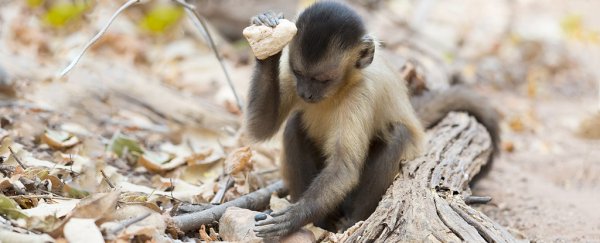Tucked away in a remote valley of Brazil's Serra da Capivara National Park, a group of bearded capuchin monkeys use round quartz stones to crack open cashew nuts on tree roots or other rocks. Beneath their feet, archaeologists have found at least 3,000-years-worth of discarded tools.
The chimpanzees of Côte d'Ivoire have been using stone tools like this for over 4,000 years, so the new discovery is not the oldest known evidence of non-human tool use. But still, there's something special about these capuchins (Sapajus libidinosus).
For some 450 generations, the monkeys who visit this site appear to have adapted their tools to the times. The newest archaeological dig has turned up 122 capuchin stone artefacts of varying sizes, and each is thought to cater to a different hardness or type of food.
The authors claim it's the first example of long-term tool variation ever discovered outside of humans.
"What is really interesting about the ability to conduct archaeological excavations on primate tool-use sites is that we as a species are not unique in having a really fine-grained and detailed archaeological record," study coauthor, archaeologist Tomos Proffitt, told National Geographic.
"This capuchin excavation shows that this species of primate in Brazil has its own individual archaeological record; they have their own antiquity to their tool use."
The oldest stones for hammering found at this site are relatively small and lightweight, though they are heavily damaged on almost all surfaces and have no traces of cashew residue. As such, the authors propose that these tools were once used for smaller food sources than cashew nuts, ones that were hard to aim at, creating more nicks and scratches on the stone.
Then, about 300 years ago, something changed. At this point, the stones the capuchins used for hammering appear much larger than the ones currently used - which suggests the monkeys still weren't aiming for cashews.
"Coupled with the fact that large anvils and anvil fragments make up the majority of artefacts from this level, the evidence suggests that capuchin percussive activity at the site during this period also centred less exclusively on cashews, and more on the opening of harder foods," the authors suggest.
It wasn't until a century ago that capuchins in this area began using rocks primed for pounding those tough cashew husks.
From what they've found so far, the authors are unable to tell whether the same capuchin population is responsible for this 'Stone Age' tool history, or if the archaeological record belongs to multiple different populations taking up residence in this area at different times.
It's also unclear why these changes were made in the first place. Could it be that cashew nuts were once less common in this region, or have the older tools simply lost their cashew residues over time?
Reading into these results is difficult, especially because the monkeys have hardly changed their hammering technique, only the size of the hammer. Without more context, the authors must simply conclude that, "While capuchins operated within the same basic stone tool percussive tradition over at least 3,000 years, they implemented this technology to different ends."
The research was published in Nature Ecology & Evolution.
